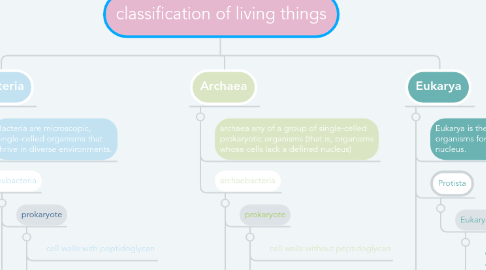
1. Bacteria
1.1. Bacteria are microscopic, single-celled organisms that thrive in diverse environments.
1.2. eubacteria
1.2.1. prokaryote
1.2.1.1. cell walls with peptidoglycan
1.2.1.2. unicellular
1.2.1.3. they are autotrophs/ heterotrophs
1.2.2. example
1.2.2.1. streptoccus, escherichia coli
2. Archaea
2.1. archaea any of a group of single-celled prokaryotic organisms (that is, organisms whose cells lack a defined nucleus)
2.2. archaebacteria
2.2.1. prokaryote
2.2.1.1. cell walls without peptidoglycan
2.2.1.2. unicellular
2.2.1.3. autotrophs/ heterotrophs
2.2.2. example
2.2.2.1. methanogens/ halophiles
3. Eukarya
3.1. Eukarya is the domain that includes organisms formed by cells with true nucleus.
3.2. Protista
3.2.1. Eukaryote cell
3.2.1.1. Cell Walls of cellulose in some; some have chloroplasts.
3.2.1.2. Most unicellular; some colonial; some multicellular.
3.2.1.3. Autotroph or heterotroph mode of nutrition
3.2.1.4. Ameoba, Paramecium
3.3. Fungi
3.3.1. Eukaryote cell
3.3.1.1. Cell walls of chitin
3.3.1.2. Most multicellular; some unicellular
3.3.1.3. Heterotroph mode of nutrition
3.3.1.4. Mushrooms, yeasts
3.4. Plantae
3.4.1. Eukaryote Cell
3.4.1.1. Cell walls of celluslose; chloroplasts
3.4.1.2. Most multicellular; some green algae unicellular
3.4.1.3. Autrotroph mode of nutrition
3.4.1.4. Flowering plants, mosses, ferns
3.5. Animalia
3.5.1. Eukaryote Cell
3.5.1.1. No cell walls or chloroplasts
3.5.1.2. Multicellular
3.5.1.3. Heterotroph
3.5.1.4. Sponges, worms, insects, fishes, mammals
